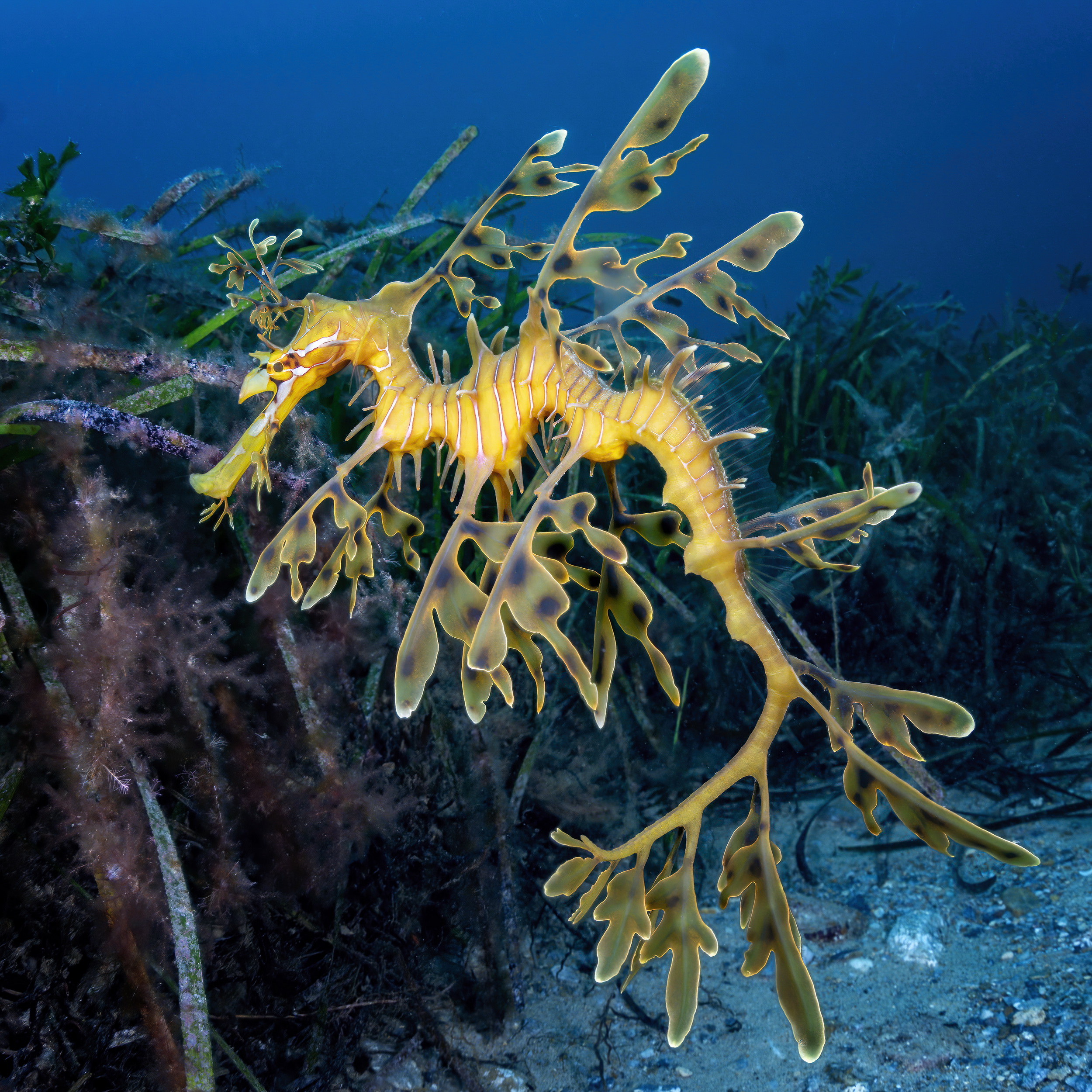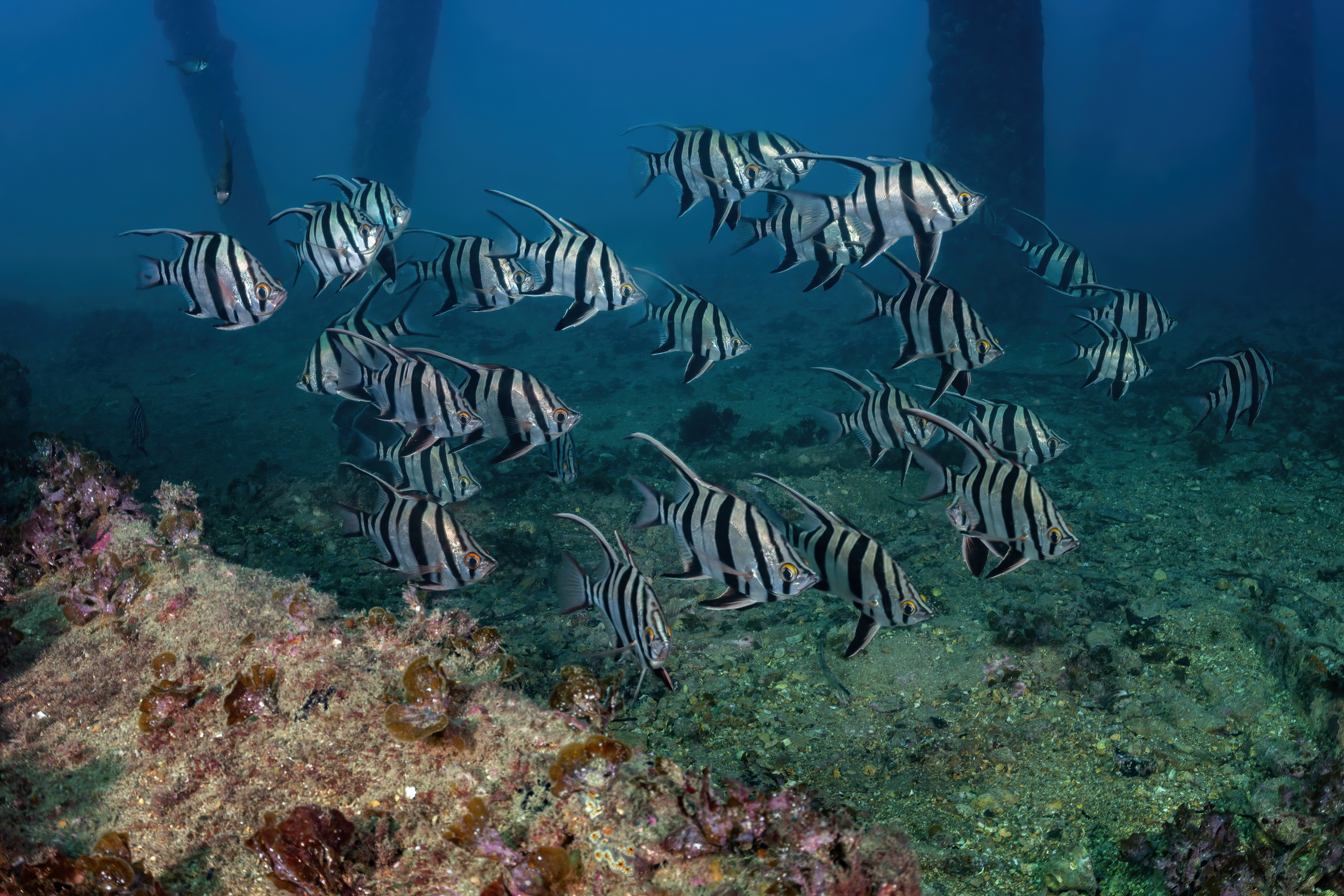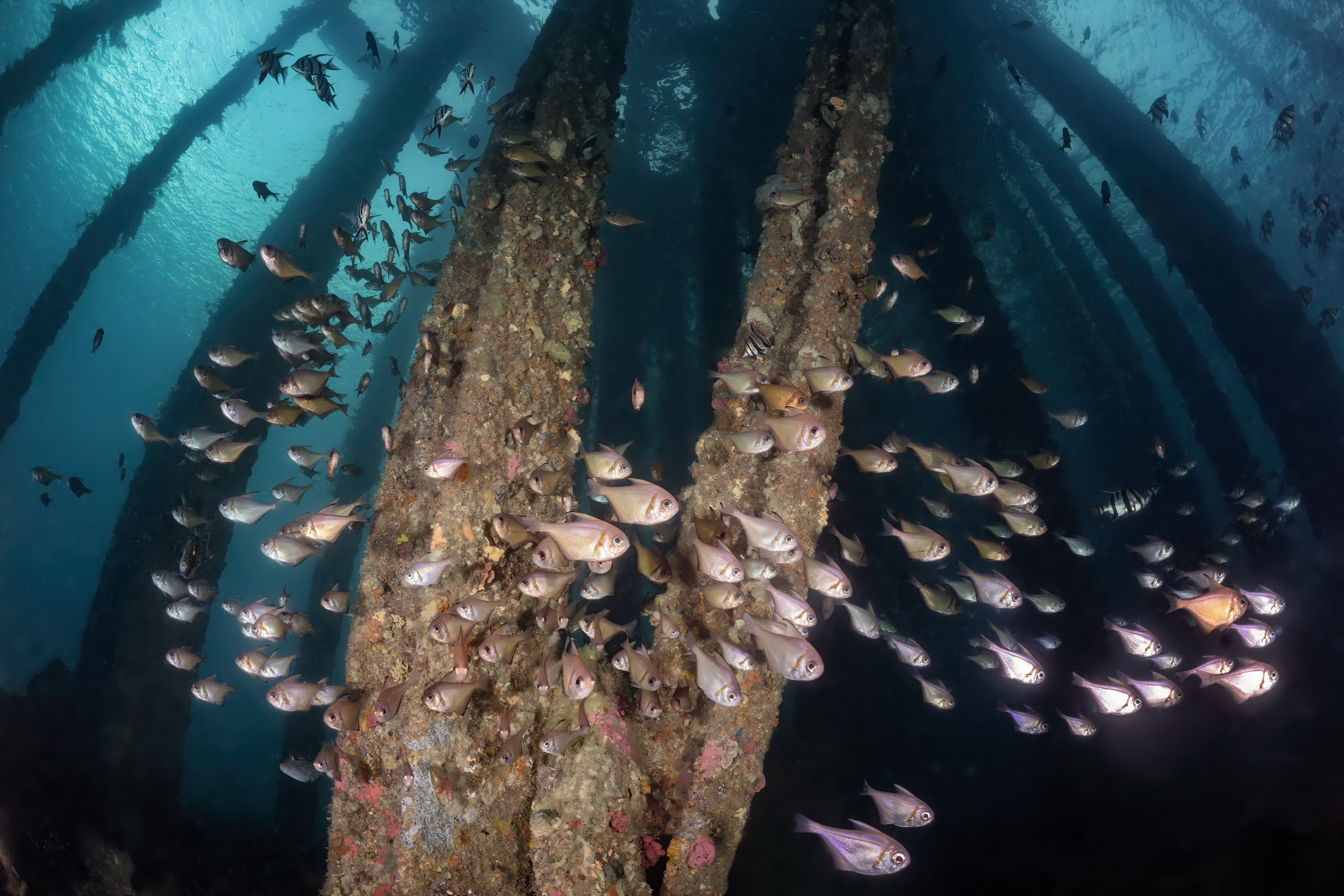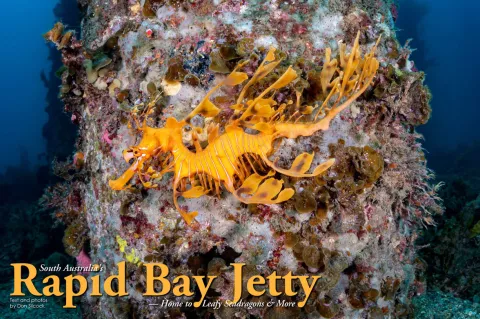There are two large, side-by-side jetties in Rapid Bay on the Fleurieu Peninsula, which are probably the most popular shore dives in South Australia.
Contributed by
Their convenient location, 100km south of the state capital of Adelaide, together with their sheltered position and great marine life makes them hard to beat. This is particularly true given the excellent chances of seeing the wonderful leafy seadragon of Australian while underwater here.
The original, much bigger jetty was built back in 1940 to allow exports from the nearby limestone mine, while the new and smaller jetty was opened in 2009. By far, the best diving is on the old jetty, particularly out at the T-section or “Tee” (aka the “Gallery” or the “Aquarium”), as it is often referred to. But the old jetty is in poor overall condition and closed to public access. So, it must be accessed by entering the water at the end of the new jetty and then crossing over.
This is straightforward overall, but not without its challenges, as getting all your gear down the new jetty is quite a haul. Then, once underwater, there is a fair distance to be covered. So, navigation and air consumption need to be managed carefully. That said, Rapid Bay truly is a great dive and well worth all the effort involved.

History
The location is named after Colonel William Light’s 162-ton survey brig, Rapid. Light was the South Australia Colonial Surveyor General, who made his first landfall on mainland South Australia here in September 1836.
Industry came to Rapid Bay in 1938 when BHP, the big Australian mining company, began quarrying limestone there, which was used as flux for the company’s steel smelters at Whyalla, Newcastle and Port Kembla. The original “BHP jetty” with its bulk-loading capability entered service in 1941, which continued through to 1988 when work was scaled down in favour of the company’s Klein Point Quarry over on the Yorke Peninsula.
The ship-loading facilities were dismantled and the quarry left a rather large hole in the ground. No real records are available on the biodiversity of the jetty prior to its closing. But it seems clear that the years since have allowed the aging pylons and overall structure to positively bloom!
However, as it aged, it also became increasingly less safe, and was finally closed to the public on Christmas Eve 2004. The new jetty was built by the state government, after an intense lobbying campaign, and came at a cost of AU$3.9m. It was formally opened to the public in 2009.
While that lobbying was strongly supported by the Scuba Divers Federation of South Australia (SDFSA), it would seem that the South Australian Recreational Fishing Advisory Council (SARFAC) was the driving force (i.e., “I fish and I vote”) behind it all. At the end of the day, what really mattered was that the new jetty was built, with tacit recognition by the politicians of the day that these structures were incredibly valuable.

Marine life
So, what is underwater at Rapid Bay? “Quite a lot” is the answer to that question! While many divers and underwater photographers visit Rapid Bay to see the iconic Australian leafy seadragon, there is much more to see. It is easy to burn all your air with the leafy seadragons (tempting as it is) and miss out on all the other stuff!
The pylons of the old jetty are testament to the rich seasonal upwellings created by the Leeuwin and Flinders Currents of southern Australia. While they lack the incredible density and almost biblical scale of those at Edithburgh Jetty, across the Gulf of St Vincent, Rapid’s pylons have much to offer.

The closing of the limestone mine and the cessation of industrial activity allowed these pylons to really flourish—just not on the same scale as Edithburgh Jetty. This is principally because of the different structures at the two jetties, with Edithbugh Jetty being quite low and wide, while Rapid Bay Jetty being higher and narrower. At Edithburgh Jetty, colourful filter-feeding ascidians and sponges dominate. But at Rapid Bay Jetty, the hard coral Culicia sp is dominant.
Like wrecks, jetties create environments for marine biodiversity to thrive. Their pylons are the catalysts, providing a strong and stable platform for growth to occur.
It is incredibly tempting at Rapid Bay Jetty to look down and forage along the seafloor. But get your buoyancy right and hover around the pylons, and you will see what I mean—with at least 49 species of fish having been recorded at the jetty.
Overall, the activity around the pylons is at its very best out on the Tee, with large schools of old wife fish and zebrafish adding a dynamic element to the towering structures of the six 10m square dolphins, which served as mooring points for ships being loaded.

There be Dragons…
Rapid Bay enjoys a strong reputation as one of the most reliable places to encounter the wonderful leafy seadragon (Phycodurus eques) of Australia, which one can find soon after entering the water and making one’s way over to the old jetty. It is not uncommon to find a “leafy” hanging out around the bottom of the pylons. But the seagrass beds on either side of the jetty often have a leafy or two as well. So, it is worth keeping a lookout for them, but do not go too far off-piste and lose the jetty!
There are rich areas of seagrass out around the Tee, which seem to be the most reliable places to find leafy seadragons, with the area on the outside of the eastern end particularly so. To get there, turn right when you get to the Tee, keep to the left edge of the structure, and head towards the end. Remember to monitor your air consumption, as it is a long way back.
Weedies too
While I have yet to see any myself, I have seen the photographs of divers who have encountered the other Australian seadragon—the less flamboyant, but almost as photogenic weedy seadragon (Phyllopteryx taeniolatus) at Rapid Bay.
“Weedies” are harder to find, it seems (certainly for me), indicating that there may be less of them than there are of “leafies”—or that they do not hang out where the leafies do.

Diving Rapid Bay
After gearing up in the car park comes the test of getting all your gear down the new jetty to the steps at the end, and the jetty is 240m long. One sure way of telling who the local divers are is their trolleys, as the visitors are the hot and sweaty ones hand-carrying their equipment.
While no doubt it is a haul, it is a huge and very welcome improvement, from previously having to scramble in from the shore and then surface swim for 300m, before the new jetty was built. Once in the water from the stairs, it is a 50m swim over to the old jetty. It is a good idea to submerge and familiarise yourself with the “star dropper” posts that show the way between the two jetties, as they will be what you are looking for on the way back.
At the old jetty, you turn right and start the 250m journey out to the Tee, where you have the decision of turning left or right. It is 100m to the end either way, and it is unlikely that you will have enough air to do both and get back to the new jetty.

Possible hazards
Rapid Bay Jetty is not a deep dive, and even right out at the Tee, it is still only about 10m, so decompression time is unlikely to be an issue. But with all that swimming, air consumption will probably be the limiting factor.
There are a few hazards to be aware and wary of, starting with getting disorientated in among all those pylons, particularly at the dog-leg on the way out to the Tee, and then around the three large square dolphins on each side of the Tee. Basically, there are so many pylons, it is easy to get confused and go the wrong way—an issue that can be compounded by possible compass errors induced by all the heavy metal surrounding you.
Secondly, be conscious of the tides at Rapid Bay. You do not want to be caught trying to get back to the new jetty in the middle of an outgoing tide.

Best time to dive, considering the wind
For local divers, the wind is a given, less so for “blow-ins.” The basic fact is that some of South Australia’s best shore dives are on opposite sides of the St Vincent Gulf, with Rapid Bay being the #1 site on the eastern side, and Edithburgh Jetty the best site on the western side.
The prevailing winds are principally from the south to southeast. So, when it is a good day at Rapid Bay, it is a really bad day at Edithburgh, and vice versa. So, if you are planning to dive Rapid Bay, you really need to check the weather forecast and understand what the wind is doing. Combine the wind information with the tide tables and you have what you need to know.
Logistics
The nearest dive shop is in Adelaide, a couple of hours away. So, you need to arrive at Rapid Bay with everything you need, including snacks and drinks, as there is nothing at the site.
It used to be that if you were spending a couple of days diving Rapid Bay, at some point in time (depending on the number of divers and cylinders involved), a “tank run” would have to be made to Adelaide.
But that changed when local diver Peter Corrigan opened an air-filling station at his home in nearby Second Valley. A new Bauer compressor, complete with storage tanks, means that refills are now quick and easy. Corrigan is reachable through his Facebook page “Second Valley Air Fills” or by phone at: 0499-229-053.
There is a parking area near the jetty, but it is long and narrow. And, because Rapid Bay is such a popular site on weekends, the available parking spots will be taken by early birds, meaning an even longer trek carrying all your gear.
Final words
There are several very good reasons why Rapid Bay is such a popular site. Pretty close to Adelaide, it is a great place to see and photograph leafy seadragons, there are numerous other things to see, and while it is a straightforward dive, it is also very interesting and has a nice touch of adventure too. It gets very busy at the weekends if the wind and tides are good, which means the car park can get a bit jammed up. But it is such a big site, there is plenty of room underwater. Dive it during the week and you may well have it all to yourself! ■
In more normal times, Don Silcock is based in Bali, Indonesia; however, due to pandemic restrictions, he is currently hunkered down in Sydney, enjoying Australian diving. For extensive location guides, articles and images on some of the best diving locations in the Indo-Pacific region and “big animal” experiences globally, visit his website at: indopacificimages.com.

















































